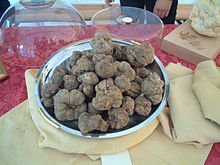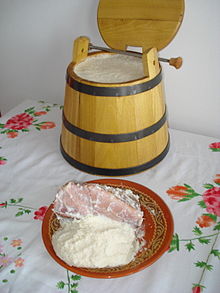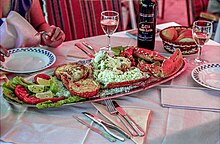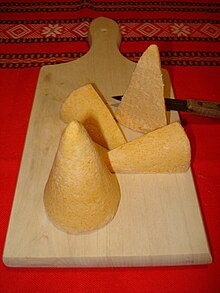Croatian cuisine
The Croatian cuisine is the national cuisine of Croatia . These include meat dishes, fish specialties, hearty soups, bacon , cheese , ham as well as local wine or herbal brandy (travarica).
How much the Croatian cuisine can be called original is controversial. The same applies to the Serbian or Romanian cuisine. The culinary "landscape" of Croatia has always been subject to change and, due to its diversity and heterogeneity, is often called the "cuisine of the regions", inspired and influenced by the former Ottoman occupiers (inland and east) and Austria - Hungary (north and north-west), while the cuisine of the coastal region is characterized by the influences of both the Greek, Roman and Illyrian as well as the modern cuisine of the Mediterranean, especially French and Italian .
Regional kitchens
The Croatian cuisine can, roughly summarized, be divided into a few regions in which very specific culinary traditions can be demonstrated that are characteristic of the respective region and that were initially not necessarily known in the rest of Croatia. Now, however, most dishes can be found across Croatia. Hence the name “regional cuisine” for the very diverse Croatian cuisine. Every area has something of its own. Paški sir (famous cheese, trademark of the island) comes from the island of Pag . The Karst areas produce the Dalmatian ham ( pršut ). In the Zagora area (inland Dalmatia ), simple dishes, bread, pork and potato dishes dominate. Inland cuisine is characterized by stews made from sauerkraut , cabbage , meat and bacon . Forest areas are known for hearty game dishes.
- Slavonia : strongly spiced cuisine with many Hungarian influences, numerous meat and game dishes, stews and goulash specialties
- Hrvatsko Zagorje and Međimurje : famous desserts and dumplings
- Central Croatia or Croatian hill country : homemade cheeses, stronger roast specialties, Ottoman influences
- Istria : cuisine with many different herbs, truffle specialties and Italian influences
- Dalmatia : Mediterranean cuisine with many Italian influences
Local dishes
Meat and game specialties
- Ćevapčići - meat rolls made from seasoned minced meat
- Ražnjići - skewers
- Pljeskavica - meat patties, meatballs
- Tafelspitz with sauerkraut (beef tail)
Seafood
- Lignje (Pl .; Italian calamari ) - (stuffed, roasted and / or baked) squid , squid
- Salata od hobotnice - octopus salad
- Tuna - tuna
- Rak norveški, škamp (Italian. Scampi (pl.)) - (breaded) scampi (emperor lobster)
- Hlap - lobster
- Jastog - lobster
- Kamenice - oysters (famous: those from the Mali-Ston Canal near Ston )
- Dagnje - mussels
Stews
- Pašticada - beef pickled in wine prepared with njoki ( gnocchi ) or noodles
- Grah - bean stew
- Riblji paprikaš - also called fiš-paprikaš (fish paprikaš ) or Čingi-lingi paprikaš (Hungarian: halászlé )
Side dishes
- Đuveč - vegetables, like ratatouille
- Blitva dalmatinski - chard vegetables with potatoes and garlic
- Sataraš - shredded and fried vegetables
- Mlinci - fried pasta
Others
- Sarma - cabbage roulade
- Arambašići - sauerkraut rolls
- Maraska cherries - sour cherries for making juice and liqueur
- Wild truffle with pasta
- Ajvar - paste made from peppers, eggplant and garlic
Sausage and ham types
- Češnjovke - spicy homemade garlic sausage from the Turopolje region
- Kobasica (Hungarian kolbász ) - Klobasse, Kolbas
- Pršut - double-smoked ham from Istria and Dalmatia
- Kulen - spicy, smoked sausage from Slavonia
- Mortadella with olives
- Salami from Samobor
cheese
- Pag cheese - sheep or goat cheese from the island of Pag
- Homemade farmer's cheese ( Škripavac ) and curd cheese from the Kordun and Lika area
- Turoš - type of cheese from Međimurje (Northern Croatia)
Bakery products
- Burek
- Pita
- Pogača also - (ung pogácsa.) Scones or brown bread called
- Soparnik - covered chard cake from the Dalmatian Poljica
Cakes and desserts
- Palačinke (Hungarian palacsinta ) - pancakes, pancakes, omelets
- Savijača or Štrudl - strudel with apple, curd cheese (quark) or other filling
- Čupavci
- Fritule
- Krofne , Krafne - donuts
- Kuglof - Bundt cake , pound cake
- Međimurska gibanica , from Međimurje (Northern Croatia)
beverages
coffee
Croatia is a country of coffee drinkers . This is u. a. due to the fact that it occupied a very important border position with the Ottoman Empire in the Austro-Hungarian monarchy . Everywhere in Croatia you come across traditional coffee houses based on the Viennese model. The most famous Croatian coffee producer is Franck . A method of making coffee that is widespread in Croatia is similar to that in Turkey: the coffee is boiled in a copper jug with added sugar and served in small cups.
Wines ( vino , pl. Vina )
Croatia has a long winemaking tradition and today produces wines of various quality levels, although these are still little known internationally. The Croatian government plans to significantly enlarge the wine-growing areas before joining the EU.
Red wines
- Mali Plavac as Postup or Dingač in Dalmatia
White wines
Dessert wines
Types of beer
In addition to a large number of imported international brands, there are also a number of domestic beers in Croatia.
- Karlovačko : brewed in Karlovac
- Ožujsko : With around 40% market share, the best-selling beer in Croatia, produced by Zagrebačka pivovara. In 2003, 1,600,000 hl were produced.
- Osječko pivo from the oldest brewery in Croatia from Osijek , then Esseg from 1694.
Liqueurs and schnapps
- Maraschino (cherry liqueur)
- Medovina (with honey)
- Gvirc (like Medovina, only richer in alcohol)
- Julischka (Slivovic and Kruškovac)
Mineral water
- Jamnica - winner of the AquaExpo Paris (so-called Eauscar ) for best mineral water 2003
- Jana - also belongs to Jamnica, best mineral water (Eauscar 2004)
See also
- Balkan cuisine
- Hungarian cuisine
- Austrian cuisine (especially Viennese cuisine ): Croatian, Hungarian and Austrian cuisine are similar in many dishes.
- Serbian cuisine
- Bosnian cuisine
literature
- Ino Kuvačić: The real Croatian cuisine: Over 90 typical recipes . Südwest Verlag, 2017, ISBN 978-3-641-21953-6 (mainly recipes from the coastal region).
- Davor Butković, Ana Ugarković: Nova hrvatska kuhinja (New Croatian Cuisine). Profile international, Zagreb 2005, ISBN 953-12-0164-1
- Ivanka Biluš et al .: Croatia at the table . Zagreb: Alfa, Koprivnica: Podravka, 1996, ISBN 953-168-104-X , 192 pages, illustrated in color, (Biblioteka Anima Croatarum, 2)
- Fazinić Nevenko, Milat Vinko: Croatian wines (Hrvatska vina). 1994, ISBN 953-173-061-X , illustrated








